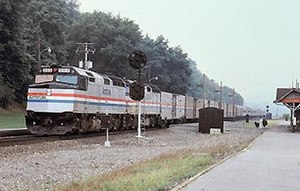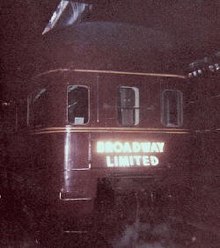
The California Zephyr was a passenger train that ran between Chicago, Illinois, and Oakland, California, via Omaha, Denver, Salt Lake City, Winnemucca, Oroville and Pleasanton in the United States. It was operated by the Chicago, Burlington & Quincy (CB&Q), Denver & Rio Grande Western (D&RGW) and Western Pacific (WP) railroads, all of which dubbed it "the most talked about train in America" on March 19, 1949, with the first departure the following day. The train was scheduled to pass through the most spectacular scenery on its route in the daylight. The original train ceased operation in 1970, though the D&RGW continued to operate its own passenger service, the Rio Grande Zephyr, between Salt Lake City and Denver, using the original equipment until 1983. In 1983 a second iteration of the California Zephyr, an Amtrak service, was formed. The current version of the California Zephyr operates partially over the route of the original Zephyr and partially over the route of its former rival, the City of San Francisco.

The Superliner is a type of bilevel intercity railroad passenger car used by Amtrak, the national rail passenger carrier in the United States. Amtrak ordered the cars to replace older single-level cars on its long-distance trains in the Western United States. The design was based on the Budd Hi-Level vehicles, employed by the Santa Fe Railway on its El Capitan trains. Pullman-Standard built 284 cars, known as Superliner I, from 1975 to 1981; Bombardier Transportation built 195, known as Superliner II, from 1991 to 1996. The Superliner I cars were the last passenger cars built by Pullman.

The Super Chief was one of the named passenger trains and the flagship of the Atchison, Topeka and Santa Fe Railway. The then-modern streamliner was touted in its heyday as "The Train of the Stars" because it often carried celebrities between Chicago, Illinois, and Los Angeles, California.

The 20th Century Limited was an express passenger train on the New York Central Railroad (NYC) from 1902 to 1967. The train traveled between Grand Central Terminal in New York City and LaSalle Street Station in Chicago, Illinois, along the railroad's "Water Level Route".

The City of Denver was a streamlined passenger train operated by the Union Pacific Railroad between Chicago, Illinois, and Denver, Colorado. It operated between 1936 and 1971. From 1936–1955 the Chicago and North Western Railway handled the train east of Omaha, Nebraska; the Chicago, Milwaukee, St. Paul and Pacific Railroad handled it thereafter. The train was the fastest long-distance train in the United States when it debuted in 1936, covering 1,048 miles (1,687 km) in 16 hours. For almost its entire career its principal competitor was the Chicago, Burlington and Quincy Railroad's Denver Zephyr. When Amtrak assumed operation of most intercity trains in the United States in 1971, it discontinued the City of Denver, preferring to use the Burlington's route between Chicago and Denver.
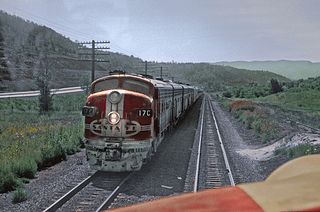
The Chief was a long-distance named passenger train of the Atchison, Topeka and Santa Fe Railway that ran between Chicago, Illinois and Los Angeles, California. The Santa Fe initiated the Chief in 1926 to supplement the California Limited. In 1936 the Super Chief was introduced, soon eclipsing the Chief as the standard bearer of the Santa Fe. The Chief was discontinued in 1968 due to high operating costs, competition from airlines, and the loss of Postal Office contracts.

The Capitol Limited was an American passenger train run by the Baltimore and Ohio Railroad, originally between New York City and Grand Central Station in Chicago, Illinois, via Union Station, Washington, D.C., Baltimore and Pittsburgh. For almost 48 years, it was the B&O's flagship passenger train, noted for personalized service and innovation. At the time of its discontinuation on May 1, 1971, when Amtrak took over most rail passenger service in the U.S., the Capitol Limited operated between Washington and Chicago.
The Federal Express was an overnight named passenger train run by the Pennsylvania Railroad and the New York, New Haven and Hartford Railroad between Washington, DC's Union Station and Boston, Massachusetts's South Station from 1912 to 1971. At different times, its route has taken it across the Hudson River via a car float between Port Morris and Jersey City, the Poughkeepsie Bridge, and finally the Pennsylvania Tunnel and Terminal Railroad. The final routing was identical to today's high-speed Northeast Corridor.

The City of San Francisco was a streamlined through passenger train which ran from 1936 to 1971 on the Overland Route between Chicago, Illinois and Oakland, California, with a ferry connection on to San Francisco. It was owned and operated jointly by the Chicago and North Western Railway (1936–55), Chicago, Milwaukee, St. Paul and Pacific Railroad (1955–71), the Union Pacific Railroad, and the Southern Pacific Railroad. It provided premium extra fare service from Chicago to San Francisco when introduced in 1936 with a running time of 39 hours and 45 minutes each way.

The National Limited was the premier train of the Baltimore and Ohio Railroad (B&O) on its route between Jersey City, New Jersey and St. Louis, Missouri, with major station stops in Washington, D.C., and Cincinnati, Ohio. It operated from 1925 to 1971. For much of its life it offered exclusive all-Pullman service, and it was the first long-distance train to be entirely air-conditioned. The National Limited was one of many trains discontinued when Amtrak began operations on May 1, 1971. Amtrak revived the name for another New York–St. Louis service which did not use the B&O route.

The Rocky Mountain Rocket was a streamlined passenger train of the Chicago, Rock Island and Pacific Railroad. Rock Island's train numbers 7 and 8 ran between Chicago's LaSalle Street Station and Denver's Union Station and Colorado Springs, Colorado. The Rocky Mountain Rocket ran from 1939 to 1966; the train was discontinued prior to the creation of Amtrak in 1971.
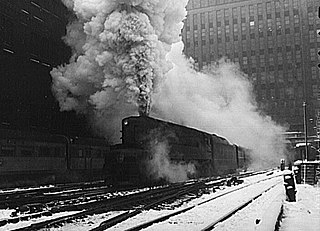
The Manhattan Limited was a passenger train of the Pennsylvania Railroad which served the Chicago—New York City route.
The General was the Pennsylvania Railroad's (PRR) number two train between New York City and Chicago. Only marginally slower than the Broadway Limited, it had no extra fare. For a time before World War II, the train carried more passengers than the Broadway Limited and had been stealing passengers from the New York Central Railroad's 20th Century Limited.
The Pittsburgher was an overnight limited passenger train operated by the Pennsylvania Railroad between New York City and Pittsburgh, Pennsylvania over the Pennsylvania's Main Line. It operated from 1924 to 1964 and one of the most prestigious trains operated by the Pennsylvania and perhaps the premier train between New York and Pittsburgh.

The Hi-Level was a type of bilevel intercity railroad passenger car used in the United States. Car types included coaches, dining cars, and lounge cars; a sleeping car variant was considered but never produced. Most passenger spaces were on the upper level, which featured a row of windows on both sides. Boarding was on the lower level; passengers climbed up a center stairwell to reach the upper level. Vestibules on the upper level permitted passengers to walk between cars; some coaches had an additional stairwell at one end to allow access to single-level equipment.
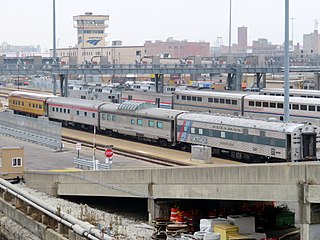
The Strata-Domes were a fleet of five streamlined dome cars operated by the Baltimore and Ohio Railroad ("B&O"). The term referred both to a pair of dome cars constructed by Pullman-Standard and three Budd Company domes the B&O acquired from the Chesapeake and Ohio Railway ("C&O"). They were the first dome cars operated in the Eastern United States, following on the success of the Chicago, Burlington and Quincy Railroad's "Vista-Domes" in the west. The cars entered service in 1949 and were all out of regular service by 1981. Several have been preserved.

The Sun Lounges were a fleet of three streamlined sleeper-lounge cars built by Pullman-Standard for the Seaboard Air Line Railroad (SAL) in 1956. The cars featured a distinctive glazed roof area meant to capture the ambience of a dome car in a lower profile, as tunnels on the East Coast of the United States prevented the use of dome cars there. The Seaboard employed all three Sun Lounges on its flagship Silver Meteor between New York City and Miami, Florida. The cars later saw service with the Seaboard Coast Line Railroad (SCL) and Amtrak. Two of the three survive in private ownership.

The Erie Limited was a streamlined passenger train operated by the Erie Railroad between Jersey City, New Jersey and Chicago, Illinois via the Southern Tier. It operated from 1929 to 1963. After the merger of the Erie and the Delaware, Lackawanna and Western Railroad (DL&W) in 1960 it was known as the Erie-Lackawanna Limited. Once the premier passenger train on the Erie, repeated service reductions in the 1950s and 1960s left it a shell of its former self. The Phoebe Snow replaced it in 1963.
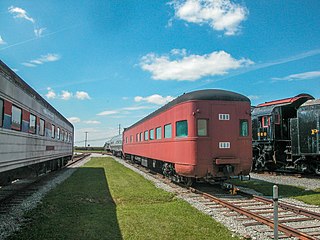
The View series was a fleet of six sleeper-observation lounges built by Pullman-Standard for use on the Pennsylvania Railroad's passenger trains. Pullman built four in 1938 and another two in 1949 after World War II. Their most prominent assignment was on the Broadway Limited, the Pennsylvania's flagship New York–Chicago train, but they were also assigned to the General and the Liberty Limited. Several of the cars have been preserved.

The Liberty Limited was a named train on the Pennsylvania Railroad. It ran from Washington D.C. to Chicago, Illinois, through Baltimore, Harrisburg and Pittsburgh. It began running on September 27, 1925, as a replacement for the Washington–Broadway Limited, which had been introduced in 1923. It originally was scheduled to complete its route in 19 hours.
